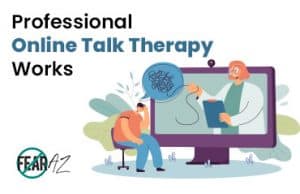Share This Article
Over the River and through the Scary Woods: Xylophobia
Do you avoid camping, hiking, and outdoor activities that take you into or near a wooded area?
Does the thought of stepping into the woods cause you to break a sweat and tremble?
You might be dealing with a fear of wooded areas called xylophobia. And while not a serious health or mental condition, xylophobia can rob you of the wonders of the outdoors.
Xylophobia is an irrational fear, which makes it hard for you to explain to your friends why the woods terrify you. The fear and general lack of support can together make you feel isolated and lonely.
Thankfully, xylophobia is treatable. Keep reading to learn how to overcome your fear of woods and more.

What Causes the Fear of Wooded Areas?
Do you repeatedly ask yourself, why am I scared of the woods at night? The answer may include a combination of factors.
Genetics
People with a family history of mental illness are at a higher risk of developing a phobia.
Traumatic Experience
A prank gone wrong or a traumatic experience involving a wooded area can also lead to a person developing xylophobia.
Learning
Sometimes, xylophobia causes can be environmental. For example, growing up with a parent or relative who has xylophobia or another anxiety condition increases your risk of developing a similar phobia.
Rational Fear of the Woods
Many people exhibit a rational fear of wooded areas. Some may fear becoming lost, some fear being attacked by a wild animal, some even fear being attacked by humans in a dark forest. However, these are rational fears, whereas xylophobia is an irrational fear.
Everything You Need to Know about Xylophobia
Also known as hylophobia, xylophobia is an irrational fear of wooded areas that can also transform into a fear of trees at night, wooden objects, wild animals, or forest sounds.
It can also be the other way around where a person develops xylophobia in response to another fear.
Unlike most other phobias, xylophobia is difficult to diagnose. Most people are unaware of their symptoms, because they live in cities and towns far from wooded areas. They may not encounter wooded areas in their daily lives.
If they do have a phobia, they may easily avoid visiting wooded areas and successfully sidestep the onset of symptoms for most of their lives.
For those who do live near a wooded area, avoidance isn’t an option. They may become aware of their feelings of fear sooner and suffer more severe symptoms. Living in constant fear of wooded areas can begin to impact their daily activities. This fear struggle may cause them to seek solutions for their phobia beyond avoidance.
Symptoms of Xylophobia
Xylophobia symptoms occur in response to the presence of triggers. These triggers most often include or are related to the subject of fear. In the case of xylophobia, a trigger can be the sound of a twig of wood snapping, a forest scene, or anything similar.
Below are some symptoms which may occur in response to a trigger.
Physical Symptoms
- Chills
- Nausea and vomiting
- Shortness of breath
- Sweating or trembling
- Dry mouth
- Headache
- Dizziness
- Increased blood pressure
- Irregular heart rate
- Tensing of the muscles
- Body aches
Psychological Symptoms
- Constantly avoiding wooded areas or objects
- Irrational thoughts or overthinking
- Anxiety and fear when thinking of wooded areas
- Insomnia
- Inability to cope with anxiety
- Delusions
- Memory lapse or fatigue
- Panic attacks
According to the DSM-5, a person may have xylophobia when they exhibit one or more symptoms for at least six months.
Dealing with Xylophobia
Like most other phobias on the list of phobias, xylophobia is treatable. But no one treatment is specifically designed for the condition.
At present, the recommended xylophobia treatment involves a combination of self-help and professional therapy.
Self-Help Strategies
For a person suffering from severe anxiety, seeking professional help can prove challenging. That’s where self-help is beneficial.
Self-help strategies, such as those mentioned below, can help one deal with and reduce anxiety outside of professional therapy.
Exercise and Yoga
Physical exercise and yoga are effective self-help strategies that lessen the effects of stress and anxiety on your mind and body.
Meditation
Practicing meditation regularly is beneficial for anyone wishing to reduce their xylophobia symptoms.
Meditation helps you become more mindful of your thoughts, feelings, and emotions. It helps you to reflect and refocus your attention on helpful subjects and constructive thoughts.
Limit Caffeine Intake
As you increase your mind and body practices, you also want to reduce your intake of caffeine. High caffeine consumption has been linked to an increased risk of anxiety and panic attacks.
Professional Help for Xylophobia
Your therapist can choose a professional treatment based on your symptoms, root cause, and severity of the anxiety. Two of the most common treatments for phobias include:
Cognitive Behavioral Therapy (CBT)
CBT is the most common treatment for a range of phobias and anxiety disorders. It focuses on helping individuals recognize negative thoughts that feed their feelings of fear. The therapist then works on replacing such thoughts with constructive ones.
Exposure Therapy
Exposure therapy also focuses on reducing feelings of fear. But unlike CBT, exposure therapy works on desensitizing individuals to the stimulus by slowly exposing them to triggers of increasing intensity.
Along with exposure, this therapy also works to teach better coping skills through the use of relaxation techniques.
Coping with Xylophobia
Coping with a phobia takes a combination of both self-help and professional therapy in addition to support from loved ones.
You also want to gather as much reliable information about your condition as possible. Ask a professional for advice on dealing with feelings of fear and anxiety. Use the internet to gather more information about the wooded areas around your region and the plants or animals you may find there.
If you do plan to make a woodland visit, take someone along or inform a close friend of your plans. Make sure to carry all essential items like food, water, first aid, GPS, and whatever makes you feel less anxious.
Takeaway
Mild xylophobia is easier to combat on your own with some self-help, knowledge, and safe exposure. But a phobia with more severe symptoms may require professional help.
If you or anyone you know is suffering from xylophobia, fear not. The condition is treatable.
With proper treatment, any person can learn to better manage their feelings of fear and enjoy the great outdoors and all it has to offer.




